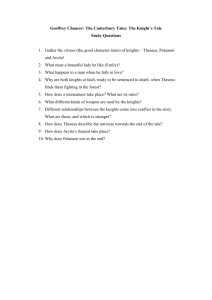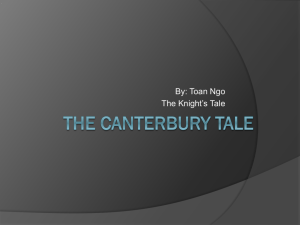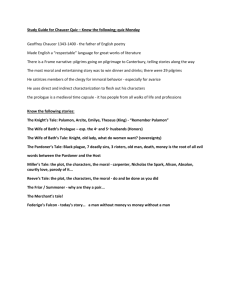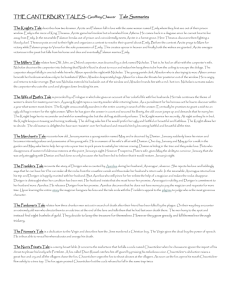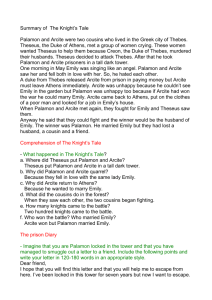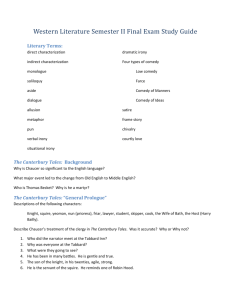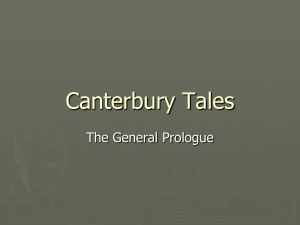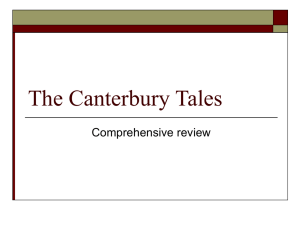Teaching the Knight’s Tale
advertisement
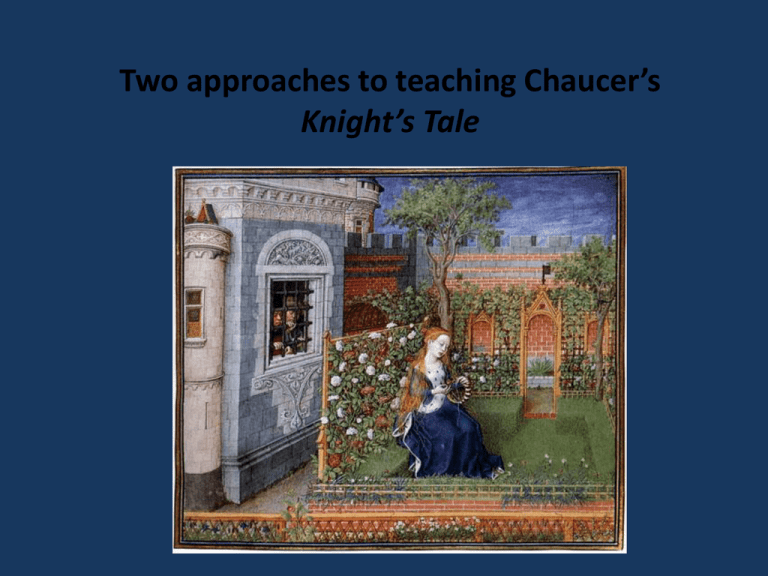
Two approaches to teaching Chaucer’s Knight’s Tale I. Structure as Style Key text: Charles Muscatine, “Form, Texture and Meaning in Chaucer’s Knight’s Tale” (PMLA 1950): the tale is about “the struggle between noble designs and chaos” and the ways in which the noble life, through its rituals and practices, makes sense of the world’s adversities A thought-experiment using the roman d’antiquite mode to address this issue in a secular (i.e., pagan) and philosophical fashion The very style of the tale emphasizes this aim: it is highly rhetorical (note, e.g., the use of occupatio) and very symmetrical (in character, setting, speech) Symmetry in character: •Palamon and Arcite: two lovers/cousins/sister's sons • two triangles overseen by an older male authority (Theseus over Palamon/ Arcite /Emelye; Saturn over Venus, Mars, Diana; alternately, Saturn/Jupiter/Venus & Mars; Egeus/Theseus/Palamon & Arcite • Troops of Palamon and Arcite are equal, and led by equally striking champions, Lycurgus and Emetrius; their equality is acknowledged explicitly at 1729-35: In al the world, to seken up and doun, So evene, withouten variacioun, Ther nere swiche compaignyes tweye, For ther was noon so wys that koude seye That any hadde of oother avauntage Of worthynesse, ne of estaat, ne age, So evene were they chosen, for to gesse. Symmetry in setting: the lists, a perfect mile in circuit with the three shrines, is built in the grove where Palamon and Arcite first fought, and where Arcite is to be buried. Symmetry in speeches and rhetoric: •Parallel speeches given by both knights upon their first sight of Emelye in Part 1 (Muscatine: Arcite’s claim—”I loved her as a woman, not a goddess”—is there to balance Palamon’s claim, not refute it) •Parallel lamentations at the end of part 1, when they are separated •Parallel prayers in the temple in part 3 •Demandes d’amour at ends of Parts 1 & 2: Yow loveres axe I now this questioun: Who hath the worse, Arcite or Palamoun? (489-90) Who looketh lightly now but Palamoun? Who spryngeth up for joye but Arcite? (1012-13) Rhetorical figures in the Knight’s Tale (1) Commutatio Two yonge knightes ligginge by and by, Bothe in oon armes, wroght ful richely, Of whiche two, Arcita highte that oon, And that other knight highte Palamon. (KT 1011-14) Dubitatio For with the rose colour stroof her hewe, I noot which was the fairere of hem two— (KT 1038-39) Interrogatio And eek therto he is a prisoner Perpetuelly, noght only for a yeer. Who coude ryme in English proprely His martirdom? For sothe, it am nat I; Therefore I passe as lightly as I may. (KT 1457-61) Rhetorical figures in the Knight’s Tale (2) Occupatio: And certes, if it nere to long to here, I wolde have told yow fully the manere How wonnen was the regne of Femenye By Theseus, and by his chivalrye; And of the grete bataille for the nones Bitwixen Athenës and Amazones; And how asseged was Ipolita, The faire hardy quene of Scithia; And of the feste that was at hir wedding, And of the tempest at hir hoomcominge; But al that thing I moot as now forbere. (KT 875-88) See also 985-1000 (battle in Thebes); 1187-89 (strife in prison of P. & A.); 2197-2207 (pre-tournament feast); 2919-2966 (Arcite’s funeral), and other instances The agent of order in this chaotic world: Theseus •A just conqueror on behalf of the Theban widows in part I •A thoughtful prince who accedes to Emelye and Hippolyta’s pleading in part 2 •Builder of the lists and the prohibitor of “destruccioun” in the tournament •Supervisor of Arcite’s funeral arrangements, and of the marriage of Palamon and Arcite •Delivers the famous “First Mover” speech, a philosophical (and specifically Neoplatonic) perspective on this uncertain world, in which we must “maken vertu of necessitee” The Knight’s Tale, then, explicitly celebrates healing power of chivalric ritual and its capacity to bring order to a world beset by chaotic and sometimes malign forces: For which anon duc Theseus leet crye, To stynten alle rancour and envye, The gree as wel of o syde as of oother, And eyther syde ylik as ootheres brother; And yaf hem yiftes after hir degree, And fully heeld a feeste dayes three, And conveyed the kynges worthily Out of his toun a journee largely. And hoom wente every man the righte way. Ther was namoore but "Fare wel, have good day!“ (1873-82) II. Irony WINDSOR, England, 4/10/2005- Prince Charles and Camilla Parker Bowles wed in a modest town hall ceremony Saturday with the blessing of the queen and the Church of England. Their bond sealed a tangled love affair ignited at a polo match more than 30 years ago. Once married, the royals knelt beneath the towering Gothic arches of St. George's Chapel in Windsor Castle, nervously pledging their undying love and confessing "sins and wickedness" - a phrase from the Church of England's Book of Common Prayer - as their vows were blessed by Archbishop of Canterbury Rowan Williams. Despite years of public and media criticism, even ridicule, Charles and Camilla's shared affection appeared to finally to have won them a measure of acceptance from the British public, many of whom blamed their relationship for poisoning Charles' marriage to Britain's beloved Princess Diana. "He did a bit of a dirty job on Diana," said Tina Quinney, 59, one of the thousands of people lining the streets of this royal town. "But the past is the past." The ceremonies went off flawlessly on a bright, sunny day despite sinister omens: A change of location for the civil wedding vows, unsubstantiated reports of the queen's "fury" that the couple would wed at all, and a one-day postponement for Pope John Paul II's funeral. WINDSOR, England, 4/10/2005- Prince Charles and Camilla Parker Bowles wed in a modest town hall ceremony Saturday with the blessing of the queen and the Church of England. Their bond sealed a tangled love affair ignited at a polo match more than 30 years ago. Once married, the royals knelt beneath the towering Gothic arches of St. George's Chapel in Windsor Castle, nervously pledging their undying love and confessing "sins and wickedness" - a phrase from the Church of England's Book of Common Prayer - as their vows were blessed by Archbishop of Canterbury Rowan Williams. Despite years of public and media criticism, even ridicule, Charles and Camilla's shared affection appeared to finally to have won them a measure of acceptance from the British public, many of whom blamed their relationship for poisoning Charles' marriage to Britain's beloved Princess Diana. "He did a bit of a dirty job on Diana," said Tina Quinney, 59, one of the thousands of people lining the streets of this royal town. "But the past is the past." The ceremonies went off flawlessly on a bright, sunny day despite sinister omens: A change of location for the civil wedding vows, unsubstantiated reports of the queen's "fury" that the couple would wed at all, and a one-day postponement for Pope John Paul II's funeral. Theseus ironized: •Erasure of human agency in First Mover speech •Bloody war with Thebes/cozy relations with “pilours”/imprisonment without ransom •Theseus the cad?: The rede statue of Mars, with spere and targe, So shyneth in his white baner large That alle the feeldes glyteren up and doun; And by his baner born is his penoun Of gold ful riche, in which ther was ybete The Mynotaur, which that he wan in Crete. Thus rit this duc, thus rit this conquerour, And in his hoost of chivalrie the flour, Til that he cam to Thebes and alighte Faire in a feeld, ther as he thoughte to fighte. What happened in Crete? From The Legend of Ariadne, in Chaucer’s Legend of Good Women Juge Infernal, Minos, of Crete king, Now cometh thy lot, now comestow on the ring; Nat for thy sake only wryte I this storie, But for to clepe agein unto memorie Of Theseus the grete untrouthe of love; For which the goddes of the heven above Ben wrothe, and wreche han take for thy sinne. Be reed for shame! now I thy lyf beginne. ***** And in an yle, amid the wilde see, Ther as ther dwelte creature noon Save wilde bestes, and that ful many oon, He made his ship a-londe for to sette; And in that yle half a day he lette, And seide, that on the lond he moste him reste. His mariners han doon right as him leste; And, for to tellen shortly in this cas, Whan Adriane his wyf a-slepe was, For that her suster fairer was than she, He taketh her in his hond, and forth goth he To shippe, and as a traitour stal his way Whyl that this Adriane a-slepe lay, And to his contree-ward he saileth blyve – A twenty devil way the wind him dryve! – And fond his fader drenched in the see. Chivalry ironized: •What’s the problem with the fight in the grove? No referees! This duc his courser with his spores smoot, And at a stert he was bitwix hem two, And pulled out a swerd and cride, "Hoo! Namoore, up peyne of lesynge of youre heed! By myghty Mars, he shal anon be deed That smyteth any strook that I may seen. But telleth me what myster men ye been, That been so hardy for to fighten heere Withouten juge or oother officere, As it were in a lystes roially.“ •The Temple of Mars: what chivalry is willing to admit about itself •Athens vs. Thebes—chivalry’s self-contradictions The Knight ironized: •Occupatio’s failures and the return of Femenye (this leads to discussion of the role of women in the tale and in chivalric discourse generally—and to the Wife of Bath’s Tale specifically) •Elision of consent in the final happy ending (not to mention the way it contradicts the “First Mover” speech: “And er that we departen from this place / I rede that we make of sorwes two / O parfit joye, lastynge everemo.”) •A paper topic of mine—”Theseus in the Knight’s Tale: principled spokesman for the chivalric life in his efforts to bring order to a chaotic world, or crypto-fascist control freak devoted to conquest?”
